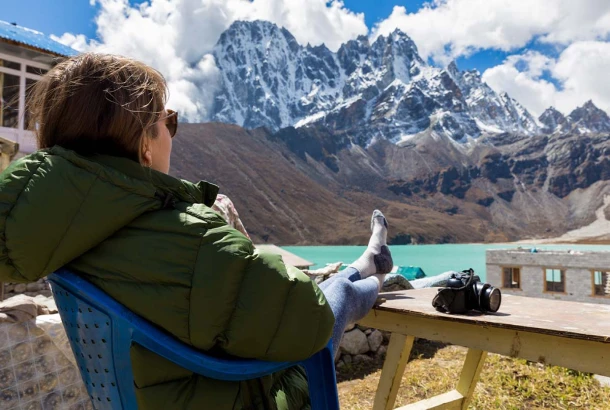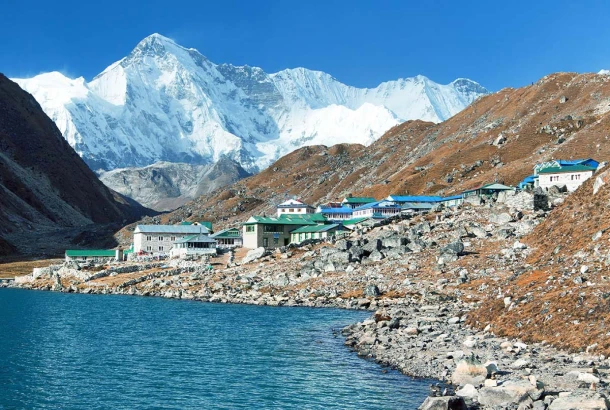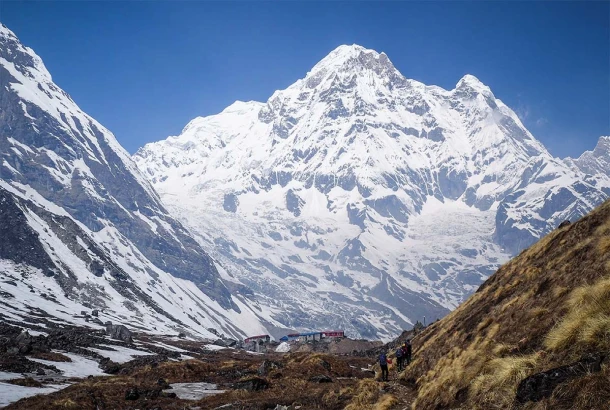Main Objectives of Conservation Areas in Nepal
- Conserve natural resources for the benefit of present and future generations.
- Bring sustainable social and economic development to local communities.
- Develop tourism in a way that minimizes negative impacts on natural, socio-cultural, and economic environments.
- Sustainable management of natural resources and rich cultural sites.
- Promote ecotourism to upgrade livelihood of local people
- Conserve the region's unique flora, fauna, and biodiversity.
- Educate public about the biodiversity conservation efforts

List of Conservation Areas in Nepal
Annapurna Conservation Area (ACA): First Conservation Area of Nepal
Annapurna Conservation Area was established in 1992 and largest protected area in Nepal. It covers an area of 7,629 square kilometers. This exceptional protected area includes the spectacular Annapurna Himalayan Ranges. The conservation area has enchanting mountains such as Annapurna, Gangapurna, Machhapuchhare, Dhaulagiri, Nilgiri, Hiunchuli, and other peaks. Enchanting Kali Gandaki River Valley, pristine glaciers, and high-altitude lakes, i.e., Tilicho Lake, are major attractions of this conservation area.
This alluring conservation area is home to more than 1,266 species plants, 105 species of mammals, 518 species of birds, 40 reptiles and 23 types of amphibians making it biologically diverse region. Key highlights include rarest of the wild: snow leopard, red panda, musk deer, Himalayan Thar, etc. Bird species like lammergeier, Brown Fish Owl, Black-faced Laughingthrush, Chukar Partridge etc are spotted in this conservation area.
Annapurna Conservation Area stands out as cultural melting pot, where visitors witness diverse traditions and customs of different ethnic groups. Thakalis, Manangis, Lobas, Magars and Gurungs. Cultural and diverse biodiversity of this region is fascinating, Which helped conservation area stand out as one of most favoured destinations for trekking and exploration.
Most popular and scenic treks pass through Annapurna Conservation Area. For trekking in this area trekkers must have Annapurna Conservation Area Permit and TIMS card. Likewise, renowned for sacred sites like Muktinath which is holy pilgrimage site for Hindus and Buddhists. In addition, several monasteries in this region add spiritual depth to visitor's journeys. Unparalleled beauty of surreal Himalayan vistas and unique culture and hospitality of locals have attracted numerous travelors worldwide contributing to its popularity.

Kanchenjunga Conservation Area
Kanchenjunga Conservation Area covers an area of 2,035 square kilometers and lies in Taplejung district of Nepal. It was established in 1998 and is renowned for its stunning natural beauty. Rich biodiversity and cultural heritage have drawn attention of the travelors. Iconic peaks include Gimmigela Chuli, Kumbakarna and Kangbachen.
In addition, pristine Yalung Glacier is scenic highlights of this area. What types of vegetation avabile in Kanchejunga? Juniper, fir, willow, birch and rhododendrons are found in subalpine area. Likewise, alpine zone hardy grasses such as Carex, Juncus and poa seen around Kanchenjunga area. Likewise, roses, gentians and rhododendrons are found in the alpine zones.
The area is culturally rich and is inhabited by several ethnic groups, including Limbu, Sherpa, and Rai people. They have their distinct traditional attire, traditions, and cultures.
Over 2,000 flowering plants, 252 birds and 22 mammal species are found in Kanchejunga. Red Panda, Clouded Leopard and Himalayan Black Bear, and are some animals that spotted in this area. Likewise, visitors catch the sights of birds like snow cock and Danphe.
The area is restricted and visitors must obtain restricted Area Permit and Kanchenjunga Conservation Area Permit. Breathtaking landscapes, farmlands, and glaciers are key highlights. Conservation area presents rugged terrain, diverse wildlife and rich cultural heritage. Which is ideal for travelors searching for destination to explore culture, observe awe inspiring vistas, as well as, experience the thrill of adventure tourism.

Manaslu Conservation Area
Manaslu Conservation Area was established in 1998 and covers an area of 1,663 square kilometers. It lies in Gorkha District of Nepal. This area covers various altitudes that range from minimum of 1400 meters to peak of Mt. Manaslu at 8163 m. Varied elevation and climate creates rich diversity of habitats where several species flora and fauna are found. Manaslu conservation is home for 33 mammal species: snow leopard, musk deer, red panda, Himalayan tahr, etc.
Likewise, 110 species of birds, including Crimson Horned Pheasant, Golden eagle, Impeyan Pheasant, etc are spotted in Manaslu conservation area. Major attractions of this protected area is flowering plants, which range between 1,500 and 2,000.
Manaslu Conservation Area is popular for scenic beauty and cultural heritage. Blessed with valleys, glaciers, and different mountain peaks such as Larkya, Mt. Manaslu, Samdo, and others renowned for offering spectacular scenery.
The Manaslu Circuit Trek and Tsum Valley Trek are popular and scenic treks that pass through this conservation area. Manaslu area requires permits for trekking. Likewise, visitors explore multiethnic villages Brahmins, Tibetans, Lamas and Gurungs and gain insights into cultural diversity of this region. Thrilling Larkya La Pass is major highlights of this region. Larkya pass has captivated adventurers worldwide because of exceptional sceneries and exhilarating experiences.
Manaslu Conservation Area Project protects the natural resources and secures local livelihoods through sustainable tourism and conservation management programs. And preserved culture and rich biodiversity offer opportunities for visitors to enjoy exceptional beauty of Nepal's scenic places.

Gaurishankar Conservation Area
Gaurishankar Conservation Area was established in 2010 and covers an area of 2,179 square kilometers within Sindhupalchowk, Ramechhap and Dolakha districts. The area is rich in water resources and is catchment of Bhotekoshi, Sunkoshi, Tamakoshi and Khimti rivers. In addition, Gaurishanker area is popular for pristine glacial Tso Rolpa lake.
The area provides habitat for many birds, reptiles, and amphibians. 77 mammals, 16 fish species, 235 bird species, 22 species of reptiles, and nine amphibian species are found in Gaurishanker Conservation Area. Significant mammals include: musk deer, clouded leopard, snow leopard, gray wolf, red panda, etc. Likewise, birds like crimson horned pheasants and impeyan pheasants are spotted in this region.
Several scenic trekking routes pass through this conservation area and present the region's hidden gems. Rolwaling trek and Tso Rolpa trek are most popular treks of this majestic conservation area.
Nepal's conservation areas rich in cultural heritage, and witness distinct traditions of ethnic groups like Jirels, Gurungs, Brahmins, Tamangs, Sherpas, etc. The area is abundant in varied vegetation as Rhododendron forest, East Himalayan Oak forest, lower temperate mixed broad-leaved forest, Alnus forest, etc. Pachermo Peak, Gaurishanker Peak, and Ramdung Peak are prominent peaks of this region renowned for their majestic beauty. Visitors explore natural beauty and witness raw charm of the region by trekking in this area and getting rewarded with hidden gems.
The area is rich in cultural heritage, biodiversity and beautiful landscapes. It offers an authentic Himalayan experience. Travelers must obtain Gaurishankar Conservation Area Permit to enter this area. Gaurishankar Conservation Area Project handles forest management and development which helps promote responsible and sustainable tourism.

Api Nampa Conservation Area
Api Nampa Conservation Area lies in far western part of Nepal, in Darchula district. Protected place is 1,903 square kilometers, with altitudes ranging from 539 meters to 7,132 meters. It was established in 2010 and named after Api Peak (7,132 m) and Nampa Peak (6,757 m). Stunning landscapes with subtropical vegetation, high alpine rugged terrains, and glaciers.
Several species of plants, birds, and mammals are spotted in Api Nampa Conservation Area. Blue Sheep, Himalayan black bear, Serow, Common Langur, Snow leopard, Blue Sheep, Goral, red panda, etc, are the animal species that found this beautiful conservation area. Birds are spotted in Api Nampa include blood pheasant, Red-billed chough, snowcock, Danphe, and Himalayan monal.
The region's climate varies according to its altitude. North area has alpine climates, whereas mid-hills have temperate climates. Likewise, in south valley, climate is subtropical. However, scenery offered by all of the places is exceptional. Api, Byas and Nampa mountains are key attractions. Medicinal plants Yarsagumba, Sarpagandha, Panchaunle, Sugandhawal etc are found in this conservation area, which is notable highlight. Brahmin, Chhetri, Thakuri, Byasi, and Bishowkarma are major cast groups in this region.
Visitors experience traditional ways of livelihood and witness rich cultural heritage and biodiversity. Which has established it as one of most favored destinations in Nepal. Api Nampa conservation area aims to preserve distinct flora and fauna of the region and focus on upliftment of local economy.

Krishnasaar Conservation Area: Smallest Conservation Area of Nepal
The Krishnasaar Conservation Area was established in 2009 A.D. Krishnasaar area is popularly known as Blackbuck Conservation Area and lies in Bardiya district. This protected area 16.95 square kilometers, which is smallest conservation area of Nepal.
The conservation area was established to preserve endangered Black Buck known as Krishnasaar. Conservation effort worked as grew to over 177 from 9 in 1975 and now it's 200. Likewise, this area is a core habitat for its survival because of the conservation effort.
This protected area provides an opportunity to witness rich ecosystem of Terai region. 109 plant species are found in this conservation area. Simal Khair (natural forests) and Sisso are two types of forests.
In addition to the Blackbuck, other wildlife species include 64 species of birds, 14 mammals, and 12 reptiles. Indian wolf, Hyaena, and wild boar are notable species that spotted in the conservation area. Likewise, plant species such as Rhododendron, Schima wallichii and Castanopsis indica add biodiversity to the area. Local communities rely on Livestock farming for their livelihood.
The guided safaris conducted in Krishnasaar Conservation Area to view blackbucks and beautiful surrounding nature. Likewise, place is the best for photography.
Visitors expect wildlife viewing, exploration of nature and bird watching which makes their journey joyful and memorable. Travelers visiting Krishnasaar area contribute to sustainable tourism and witness Nepal's commitment to preserving its endangered wildlife.

Wildlife Reserves and National Parks of Nepal
National Parks
National parks are designated areas that government sets with objective of preservation natural environment, wildlife and cultural heritage. These parks are established mainly to protect ecosystems of the natural environment. Likewise, these areas are legally protected and managed by responsible authorities assigned by government.
Nepal is blessed with diverse ecosystems. The national parks are established to focus on conserving unique biodiversity of the country. National parks work for the protection of forests, wetlands, grasslands and wildlife.
Likewise, parks promote sustainable tourism to ensure human activities do not harm natural environment. Local communities receive huge support from national park for development of eco-tourism, research and long-term environmental sustainability.
List of National Parks in Nepal
- Banke National Park
- Makalu Barun National Park
- Parsa National Park
- Bardiya National Park
- Chitwan National Park
- Shey-Phoksundo National Park
- Khaptad National Park
- Langtang National Park
- Sagarmatha National Park
- Shivapuri Nagarjun National Park
- Shukla Phanta National Park
Wildlife Reserve in Nepal
The wildlife reserves of Nepal play an important role in conservation of endangered species. Contribute to maintaining ecological balance. In addition, these reserves work to preserve wildlife and offer opportunities for ecotourism and sustainable livelihoods to local communities.
Wildlife reserves of Nepal are:
- Koshi Tappu Wildlife Reserve
- Parsa National Park/ Wildlife Reserve
- Shuklaphanta National Park/ Wildlife Reserve

Popular Treks National Parks and Conservation Areas of Nepal
Most popular trekking routes pass through several conservation areas of Nepal. Nepal trekking provide an opportunity to behold beauty of the Himalayas. In addition, trekkers witness unique biodiversity and culture.
Popular Treks in Nepal's Conservation Areas
Annapurna Conservation Area
Manaslu Conservation Area
Kanchenjunga Conservation Area

Popular Treks in National Parks of Nepal
Langtang National Park
Sagarmatha National Park
Makalu Barun National Park
Shey Phoksundo National Park
Gaurishankar Conservation Area
- Tsho Rolpa Lake trek
- Dudh Kunda Lake Trek
- Rolwaling trek
Why Trek in Protected Areas of Nepal?
Trekking in conservation areas offers adventurers an opportunity to witness natural beauty of Nepal. Trekkers observe preserved culture and ecological richness of Nepal while passing through the national parks and conservation areas.
These areas promote sustainable tourism, making your journey meaningful and impactful. In addition, witness raw beauty of extraordinary landscapes and culture, enhance your overall experience.
Role of Protected Areas Biodiversity Conservation in Nepal
The protected areas play an important role in preserving rich biodiversity. Nepal is gifted with unique ecosystems, rare flora, and fauna. Protected areas wildlife reserves, national parks, and conservation areas of Nepal. Established to protect species while supporting sustainable tourism activities.
Key aspects of role in biodiversity conservation in Nepal.
- Protected areas contribute to wildlife and habitat protection by planning core zones to protect wildlife and buffer zones. The buffer zones are important for managing the relationship between preservation efforts and local communities. Ensures ecological stability and human livelihoods are supported and helps in biodiversity conservation.
- Authorities managing the protected areas have surveillance systems to prevent illegal hunting and trafficking.
- Major objectives of protected areas is Habitat restoration. For this, huge efforts are made to reforestation, regulate the species, and restore natural ecosystem. In addition, population of the key species is monitored to track changes and highlight the emerging issue.
- Trekking Permit systems, Annapurna Conservation Area Permits and Manaslu Conservation Areas Permits, Restricted areas permits are implemented to regulate trekking activities, maintenance trails, security visitors, and development of sustainable tourism in protected areas.
- Strict laws are enforced in protected areas to prevent illegal mining and poaching. All conservation policies are implemented with the support of local authorities.

Ecotourism in Wildlife Conservation Areas of Nepal
Ecotourism plays crucial role in preservation and sustainable development of wildlife conservation areas in Nepal. Eco tourism involves environmental conservation and community development while focusing on sustainability. Additionally, it contributes to the conservation of wildlife to maintain a balance between tourism and protection of environment. Responsible travel to natural areas hugely contributes well-being of wildlife. Ecotourism helps to spread awareness about importance of protecting endangered species. Many programs are organized to educate people about ecological relevance of species.
Nepal has a diverse range of ecosystems. Varied flora and fauna, including many endangered species, spotted in subtropical jungles in the Terai and alpine regions.
Eco-Tourism in Wildlife Conservations Contributions
- The revenue from park entry fees and permits is utilized for wildlife protection efforts such as anti-poaching patrols and research. Funds are used in the establishment of buffer zones that are crucial for species movement and their conservation.
- Following principle of eco-tourism and promoting sustainable practices helps communities become more focused on preserving wildlife, which helps maintain the ecosystem.
- Local communities report if they encounter any suspicious activities that harm wildlife, which helps in conservation efforts of authorities.
- Responsible travelors and researchers have collected the journals and photographs of the wildlife, which helped authorities to understand behavior of the wildlife. From this observation, they can develop conservation strategies.
- Eco-tourism focuses on getting local community involved in the wildlife conservation. Betterment of local communities is key focus areas of eco tourism. So, village and community homestays are established where local communities can participate. This helps locals become aware importance of wildlife preservation, and get actively involved in promoting it among visitors. Eco-Tourism in Wildlife Conservations

Consolation
The conservation areas of Nepal play a critical role in preserving the country’s rich biodiversity, unique ecosystems, and cultural heritage. Nepal's best Conservation areas are: Annapurna, Manaslu, Kanchenjunga, Langtang, Gaurishankar, Api Nampa, Krishnasaar, etc. Contribute to sustainable tourism, provide livelihoods for local communities, and climate change impacts. Proper management and awareness are key to ensuring the long-term protection of invaluable natural resources.
Are you interested to explore National Park! Check our Top Ten Touristic National Parks of Nepal, your desire will be fulfill and you are able to find best.
















